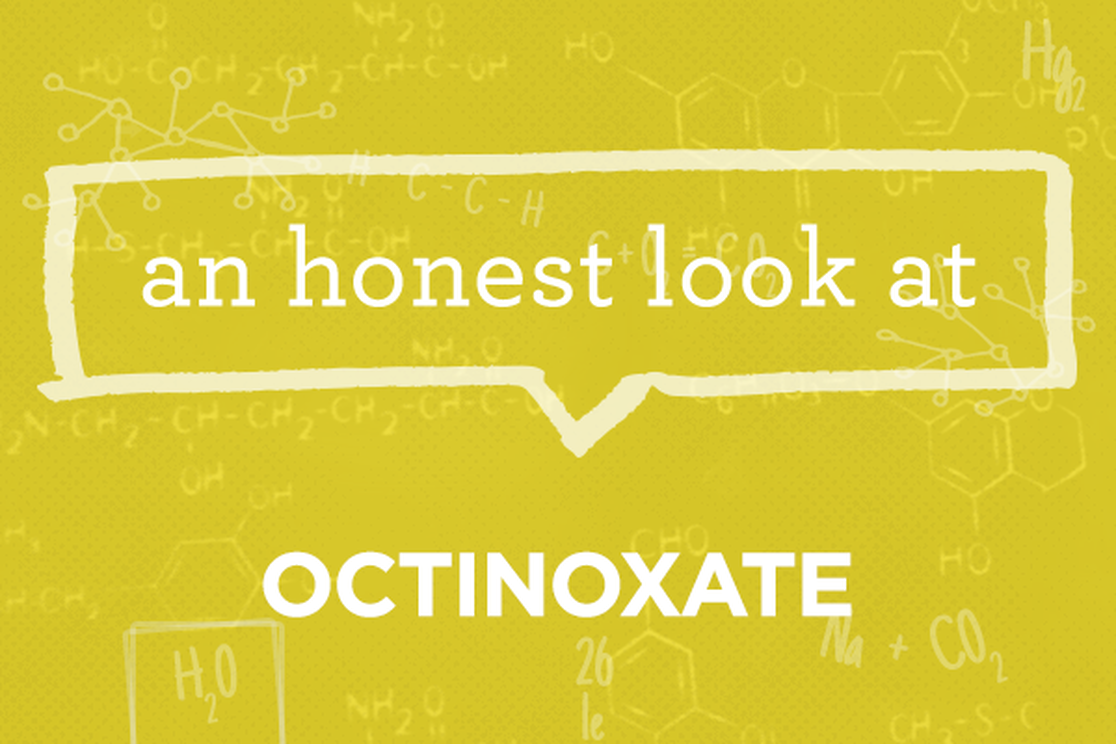This is part of our ongoing series helping consumers better understand chemicals, chemistry, and product formulations. We translate the science, bust the myths, and give you an honest assessment, so you can make informed choices for your family!
Ingredient:
Octinoxate (also known as octyl methoxycinnamate [OMC], parsol, parsol MCX, parsol MOX, escalol, 2-ethylhexyl p-methoxycinnamate)
What is Octinoxate?
Octinoxate is created by combining methoxycinnamic acid (which can be extracted from the Aquilegia vulgaris plant) and 2-ethylhexanol (1).
What it does:
Octinoxate filters UVB rays from the sun and is the most widely used chemical absorber in the skincare industry (2). It’s also found in hair color products, shampoos, lipstick, nail polish, and more where it functions as a UV filter to protect the products from degrading when exposed to sunlight (3).
Why we’re featuring it today:
In explaining why we have chosen to use mineral vs. chemical sunscreens, it’s important to note the differences between the two. Studies suggest that many chemical sunscreens are absorbed into the skin, and thus make their way into the bloodstream (while mineral sunscreens like non-nano zinc oxide are not). Why is this important? Chemical absorbers such as Octinoxate are increasingly being linked to potentially negative health impacts (see below).
- It’s shown hormone disruption tendencies (4-12).
- It can be absorbed through the skin, so it’s showing up in plasma, urine and breastmilk (13,14). Infant exposure through breastfeeding is especially concerning.
For these reasons, we have included Octinoxate in our Honestly Free Guarantee (the list of ingredients our products are made without). While more research is needed to assess the potential impacts of this chemical absorber, we believe it’s better to be safe than sorry – especially when there’s a known, safe alternative for sunscreen.
References:
- Bylka, W. (2003). E-and Zp-methoxycinnamic acid from Aquilegia vulgaris.Acta poloniae pharmaceutica, 61(4), 307-308.
- Skin Cancer Foundation. (n.d.). Retrieved March 14, 2016, from http://www.skincancer.org/prevention/sun-protection/sunscreen/the-skin-cancer-foundations-guide-to-sunscreens
- Svin, I. (2006). Update of Sunscreen Ingredients Nomination to NTP. National Toxicology Program. Retrieved March 14, 2016, from https://ntp.niehs.nih.gov/ntp/htdocs/chem_background/exsumpdf/5466-77-3_508.pdf
- Darbre, P. D. (2006). Environmental oestrogens, cosmetics and breast cancer. Best practice & research clinical endocrinology & metabolism, 20(1), 121-143.
- Dingle, P. (2009). Sour on sunscreens. Journal of Complementary Medicine: CM, The, 8(6), 5.
- Schlumpf, M., Cotton, B., Conscience, M., Haller, V., Steinmann, B., & Lichtensteiger, W. (2001). In vitro and in vivo estrogenicity of UV screens. Environmental health perspectives,109(3), 239.
- Schlumpf, M., Schmid, P., Durrer, S., Conscience, M., Maerkel, K., Henseler, M., … & Lichtensteiger, W. (2004). Endocrine activity and developmental toxicity of cosmetic UV filters—an update. Toxicology, 205(1), 113-122.
- Krause, M., Klit, A., Blomberg Jensen, M., Søeborg, T., Frederiksen, H., Schlumpf, M., ... & Drzewiecki, K. T. (2012). Sunscreens: are they beneficial for health? An overview of endocrine disrupting properties of UV‐filters.International journal of andrology, 35(3), 424-436.
- Akunna, G. G., Saalu, L. C., Ogunlade, B., Akingbade, A. M., Anderson, L. E., & Olusolade, F. S. (2015). Histo-morphometric evidences for testicular derangement in animal models submitted to chronic and sub-chronic inhalation of fragrance. American Journal of Research Communication, 3(1), 85-101.
- Kunz, P. Y., & Fent, K. (2006). Multiple hormonal activities of UV filters and comparison of in vivo and in vitro estrogenic activity of ethyl-4-aminobenzoate in fish. Aquatic Toxicology, 79(4), 305-324.
- Szwarcfarb, B., Carbone, S., Reynoso, R., Bollero, G., Ponzo, O., Moguilevsky, J., & Scacchi, P. (2008). Octyl-methoxycinnamate (OMC), an ultraviolet (UV) filter, alters LHRH and amino acid neurotransmitters release from hypothalamus of immature rats. Experimental and clinical endocrinology & diabetes: official journal, German Society of Endocrinology [and] German Diabetes Association, 116(2), 94-98.
- Klammer, H., Schlecht, C., Wuttke, W., Schmutzler, C., Gotthardt, I., Köhrle, J., & Jarry, H. (2007). Effects of a 5-day treatment with the UV-filter octyl-methoxycinnamate (OMC) on the function of the hypothalamo-pituitary–thyroid function in rats. Toxicology, 238(2), 192-199.
- Janjua, N. R., Mogensen, B., Andersson, A. M., Petersen, J. H., Henriksen, M., Skakkebæk, N. E., & Wulf, H. C. (2004). Systemic absorption of the sunscreens benzophenone-3, octyl-methoxycinnamate, and 3-(4-methyl-benzylidene) camphor after whole-body topical application and reproductive hormone levels in humans. Journal of Investigative Dermatology, 123(1), 57-61.
- Hany, J., & Nagel, R. (1995). Detection of sunscreen agents in human breast-milk. Deutsche Lebensmittel-Rundschau, 91(11), 341-345.
- Axelstad, M., Boberg, J., Hougaard, K. S., Christiansen, S., Jacobsen, P. R., Mandrup, K. R., … & Hass, U. (2011). Effects of pre-and postnatal exposure to the UV-filter Octyl Methoxycinnamate (OMC) on the reproductive, auditory and neurological development of rat offspring. Toxicology and applied pharmacology, 250(3), 278-290.
We aim to provide you with the most honest and credible information possible. This article was reviewed for accuracy by The Honest Team and its internal technical experts.
blog_review_statement



